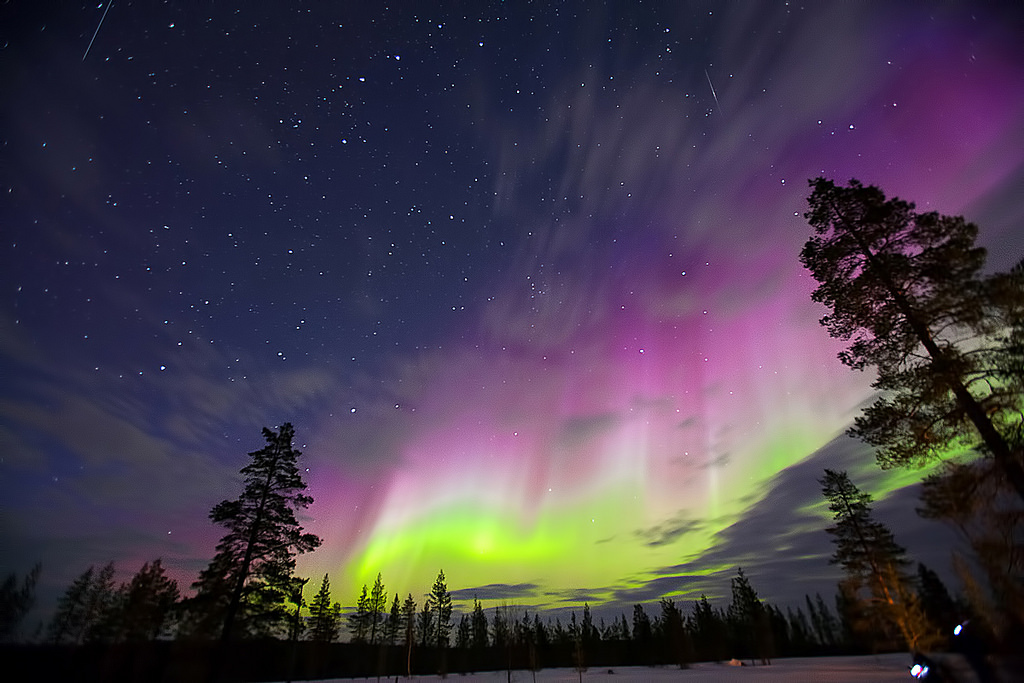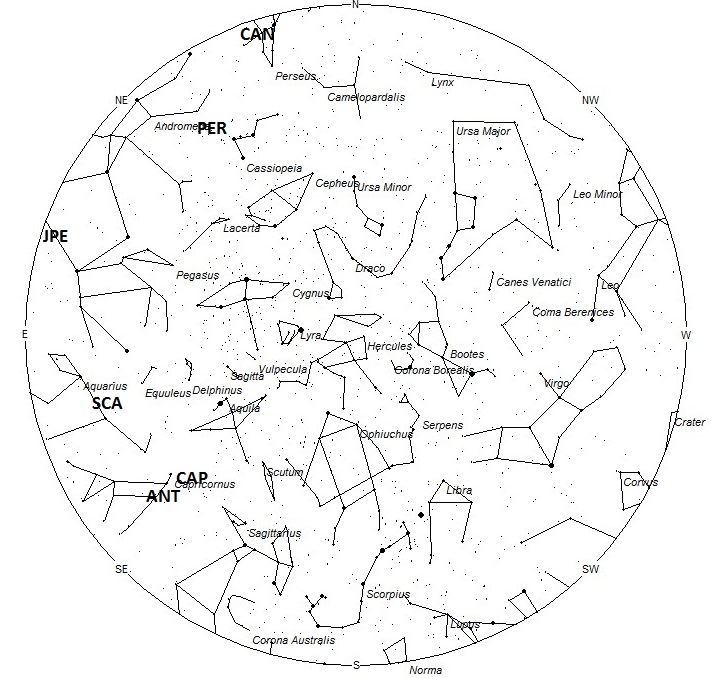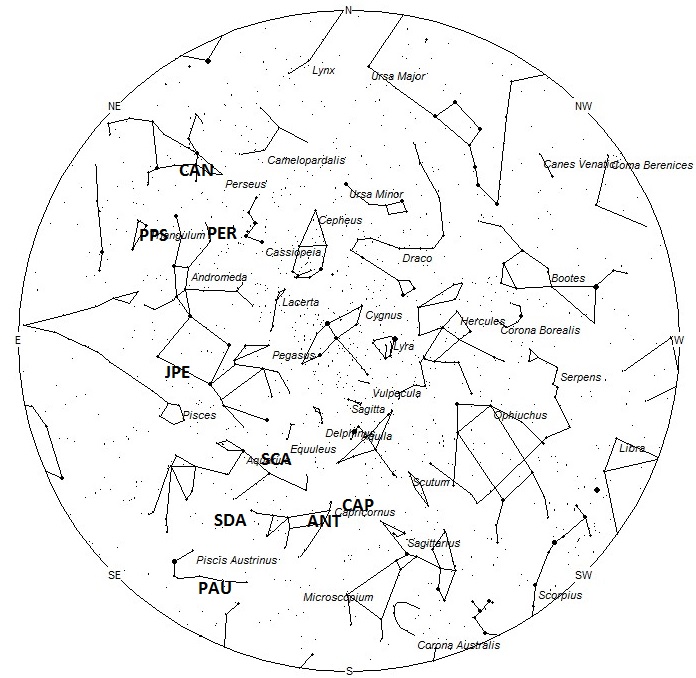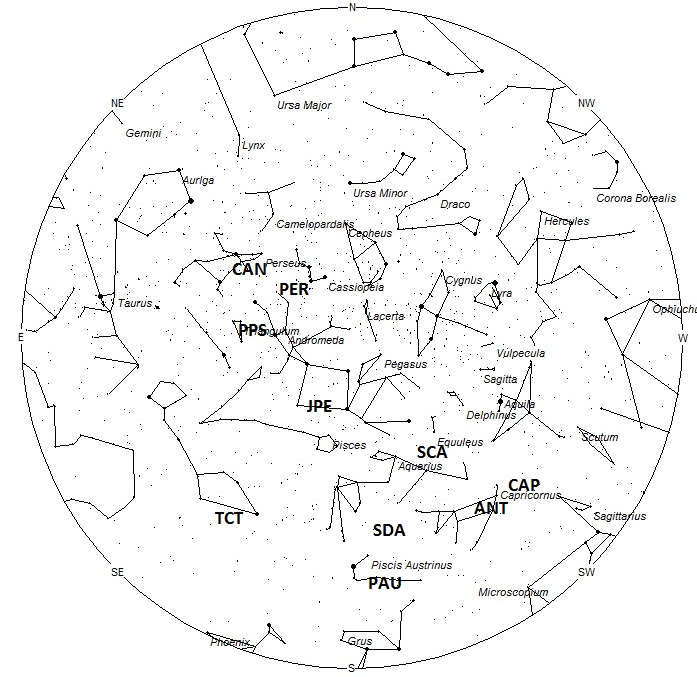
Northern Lights and 2 meteors – 18.03.2015 Finland by Dave Grubb
During this period the moon reaches its first quarter phase on Thursday July 23rd. At this time the moon is located 90 degrees east of the sun and sets near midnight local daylight time (LDT). This weekend the waxing crescent moon will set during the late evening hours and will not interfere with meteor observing. The estimated total hourly meteor rates for evening observers this week is near 4 no matter your location. For morning observers the estimated total hourly rates should be near 13 no matter your location. The actual rates will also depend on factors such as personal light and motion perception, local weather conditions, alertness and experience in watching meteor activity. Note that the hourly rates listed below are estimates as viewed from dark sky sites away from urban light sources. Observers viewing from urban areas will see less activity as only the brightest meteors will be visible from such locations.
The radiant (the area of the sky where meteors appear to shoot from) positions and rates listed below are exact for Saturday night/Sunday morning July 18/19 These positions do not change greatly day to day so the listed coordinates may be used during this entire period. Most star atlases (available at science stores and planetariums) will provide maps with grid lines of the celestial coordinates so that you may find out exactly where these positions are located in the sky. A planisphere or computer planetarium program is also useful in showing the sky at any time of night on any date of the year. Activity from each radiant is best seen when it is positioned highest in the sky, either due north or south along the meridian, depending on your latitude. It must be remembered that meteor activity is rarely seen at the radiant position. Rather they shoot outwards from the radiant so it is best to center your field of view so that the radiant lies at the edge and not the center. Viewing there will allow you to easily trace the path of each meteor back to the radiant (if it is a shower member) or in another direction if it is a sporadic. Meteor activity is not seen from radiants that are located below the horizon. The positions below are listed in a west to east manner in order of right ascension (celestial longitude). The positions listed first are located further west therefore are accessible earlier in the night while those listed further down the list rise later in the night.
These sources of meteoric activity are expected to be active this week.
The Alpha Capricornids (CAP) are active for over a month lasting from July 6 through August 10. Unlike most showers, the Alpha Caps have a plateau-like maximum with maximum activity lasting from July 25-30. Since maximum activity is still a week away, hourly rates will be near 1 no matter your location. The radiant is currently located at 19:52 (298) -12. This area of the sky is located on the Aquila/Sagittarius border, 5 degrees west of the 4th magnitude star known as Algedi (Alpha Capricornii). The radiant is best placed near 0100 local daylight time (LDT) when it lies on the meridian and is highest in the sky. With an entry velocity of 22 km/sec., the average Alpha Capricornid meteor would be of slow velocity.
The center of the large Anthelion (ANT) radiant is currently located at 20:36 (309) -17. This position lies in western Capricornus, 3 degrees southeast of the 3rd magnitude star known as Dabih (Beta Capricorni). These meteors may be seen all night long but the radiant is best placed near 0200 LDT when it lies on the meridian and is positioned highest in the sky. Due to the large radiant area, meteors from this source may also appear to radiant from the constellation of Microscopium, southern Aquila, western Aquarius, and eastern Sagittarius as well as Capricornus. Rates at this time should be near less than 1 per hour as seen from the northern hemisphere and 1 per hour as seen from south of the equator. With an entry velocity of 30 km/sec., the average Anthelion meteor would be of slow velocity.
The Sigma Capricornids (SCA) were discovered by Zdenek Sekanina and are active for a month lasting from June 19 through July 24. Maximum occurred on June 27th. The radiant is currently located at 21:36 (324) -02. This area of the sky is located in northern Aquarius, 3 degrees north of the 3rd magnitude star known as Sadalsuud (Beta Aquarii). The radiant is best placed near 0300 LDT when it lies on the meridian and is highest in the sky. Rates at this time should be less than 1 per hour no matter your location. With an entry velocity of 42 km/sec., the average Sigma Capricornid meteor would be of medium velocity.
Activity from the Delta Aquariids (SDA) will begin next week from a radiant located at 22:08 (332) -19. This position is located in southwestern Aquarius, 10 degrees southwest of the third magnitude Delta Aquarii. Maximum activity is expected on July 29th. Hourly rates will depend on your latitude. Those viewing from the southern tropics will see the best rates of near 1-2 per hour. Rates seen from mid-northern latitudes will range from 0-1 per hour, depending on the haziness of your skies. The radiant rises near 2200 (10pm) LDT for observers located in the mid northern latitudes, but is best placed near 0300 LDT, when it lies highest in the sky. With an entry velocity of 42 km/sec., most activity from this radiant would be of average velocities.
The Piscids Austrinids (PAU) are a minor shower not well seen from the northern hemisphere. This radiant is active from July 15 through August 10. Maximum activity occurs on July 28 when the zenith hourly rate (ZHR) may reach five. These rates are only seen from the southern hemisphere where the radiant passes overhead. From mid-northern latitudes, rates of one per hour at maximum are usually seen. The radiant is currently located at 22:16 (334) -34. This position lies in central Piscis Austrinus, 9 degrees southwest of the bright first magnitude star Fomalhaut (Alpha Piscis Austrinus). The radiant is best placed near 0300 LDT, when it lies highest in the sky. With an entry velocity of 35km/sec., most activity from this radiant would be of average velocities.
The July Pegasids (JPE) are active from a radiant located at 23:40 (355) +13. This area of the sky is located in southern Pegasus, between the 3rd magnitude star Algenib (Gamma Pegasi) and the 2nd magnitude star known as Markab (Alpha Pegasi). This area of the sky is best seen during the last dark hour before dawn when the radiant lies highest in a dark sky. Maximum activity occurred on July 10th so rates this weekend are expected to be near less than 1 per hour no matter your location. With an entry velocity of 68 km/sec., the average meteor from this source would be of swift velocity.
The Perseids (PER) are active from a radiant located at 00:40 (010) +52. This area of the sky lies in southern Cassiopeia, 5 degrees south of the 2nd magnitude star known as Schedar (Alpha Cassiopeiae). Since the maximum is nearly a month away, rates are expected to be low, probably around 2 per hour during the late morning hours. Observers south of the equator will have difficulty seeing any activity as the radiant lies low in the north at best. With an entry velocity of 61 km/sec., the average Peresid meteor would be of swift speed.
The Tau Cetids (TCT) were discovered by Sirko Molau using data from the IMO video database. This activity is only active on 4 nights with maximum activity occurring on the 21st. The radiant is located at 01:20 (020) -18, which places it in southern Cetus, 7 degrees east if the 2nd magnitude star known as Deneb Kaitos (Beta Ceti). Rates would most likely be less than 1 as seen from the northern hemisphere and perhaps 1 per hour for observers located south of the equator. These meteors would be best seen during the last hour before dawn when the radiant lies highest in a dark sky. With an entry velocity of 65 km/sec., the average meteor from this source would be of swift velocity.
The Phi Piscids (PPS) were discovered by Dr. Peter Brown in his meteoroid stream survey using the Canadian Meteor Orbit Radar. This shower was later verified by Dr. Peter Jenniskens and David Holman using data from the CAMS network in northern California. These meteors are active from June 11 through July 25 with maximum activity occurring on July 2nd. The current position of the radiant is 01:56 (029) +34. This position lies in the constellation of Triangulum, 5 degrees north of the 3rd magnitude star known as Ras al Muthallah (Alpha Trianguli). Rates are currently expected to be near 1 per hour for observers in the northern hemisphere and less than 1 for observers located south of the equator. With an entry velocity of 68 km/sec., the average Phi Piscid meteor would be of swift speed.
Activity from the c-Andromedids (CAN) is ending this weekend. The radiant currently lies at 02:48 (042) +50, which places it in western Perseus, 5 degrees west of the 2nd magnitude star known as Mirfak (Alpha Persei). This area of the sky is best seen during the last dark hour before dawn when the radiant lies highest in a dark sky. Observers in the northern hemisphere are better situated to view this activity as the radiant rises much higher in the sky before dawn as seen from northern latitudes. Current rates would be less than one per hour no matter your location. With an entry velocity of 60 km/sec., the average meteor from this source would be of swift velocity.
As seen from the mid-northern hemisphere (45N) one would expect to see approximately 8 sporadic meteors per hour during the last hour before dawn as seen from rural observing sites. Evening rates would be near 3 per hour. As seen from the tropical southern latitudes (25S), morning rates would be near 7 per hour as seen from rural observing sites and 3 per hour during the evening hours. Locations between these two extremes would see activity between the listed figures.
The table below presents a list of radiants that are expected to be active this week. Rates and positions are exact for Saturday night/Sunday morning except where noted in the shower descriptions.
| SHOWER | DATE OF MAXIMUM ACTIVITY | CELESTIAL POSITION | ENTRY VELOCITY | CULMINATION | HOURLY RATE | CLASS |
| RA (RA in Deg.) DEC | Km/Sec | Local Daylight Time | North-South | |||
| Alpha Capricornids (CAP) | Jul 27 | 19:52 (298) -12 | 22 | 01:00 | 1 – 1 | II |
| Anthelions (ANT) | – | 20:36 (309) -17 | 29 | 02:00 | <1 – 1 | II |
| Sigma Capricornids (SCA) | Jun 27 | 21:36 (324) -02 | 42 | 03:00 | <1 – <1 | IV |
| Delta Aquariids (SDA) | Jul 29 | 22:08 (332) -19 | 42 | 03:00 | 1 – 2 | I |
| Piscids Austrinids (PAU) | Jul 28 | 22:16 (334) -34 | 35 | 03:00 | <1 – <1 | II |
| July Pegasids (JPE) | Jul 10 | 23:40 (355) +13 | 68 | 04:00 | <1 – <1 | IV |
| Perseids (PER) | Aug 13 | 00:40 (010) +52 | 61 | 05:00 | 2 – 1 | I |
| Tau Cetids (TCT) | Jul 21 | 01:20 (020) -18 | 65 | 06:00 | <1 – 1 | IV |
| Phi Piscids (PPI) | Jul 01 | 01:56 (029) +34 | 69 | 06:00 | 1 – <1 | IV |
| c-Andromedids (CAN) | Jul 10 | 02:48 (042) +50 | 60 | 07:00 | <1 – <1 | IV |
 American Meteor Society
American Meteor Society



On 07/22/15 at approximately 11:30 p.m. I did not look at the clock at that time, but it was between 11 pm and 12 am. I was looking west, out my bedroom window and saw a large white light, assumed to be a meteor or fireball, slightly less than 45 degrees above horizon. It was moving from north to south at a high rate of speed and I only had sight of it for approximately 1 second before it disappeared. A few seconds later I observed a flash of light illuminating the night sky from the south as if there were an explosion. No sound was heard.
I saw something similar at about the same time. I am located in Corpus Christi, Texas. I was at work and around 10:30 PM Central Time I looked up from my workstation and looked out the Hangar door which was wide open and saw what I would call a very large fire ball. It was a very white bright ball of light with a trailing tail of orange fire. It was to close, to low and to large to be a shooting star. I too only caught a split second glimpse as it disappeared behind the hanger next to the one I was in. I would think that it must have impacted the earth somewhere. The size and appearance of it (burning) makes me believe it must have been in our atmosphere.